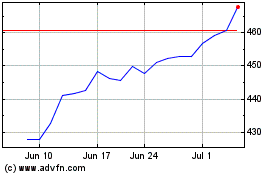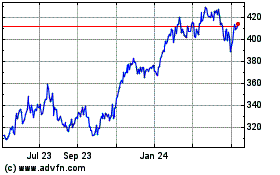(FROM THE WALL STREET JOURNAL 1/29/16)
By Chelsey Dulaney
Microsoft Corp. continued an era of renewed vitality in the
latest quarter, showing progress in newer cloud-computing services,
as well established business lines such as the Windows operating
system.
The company's revenue and profit for the period ended in
December, though both declined, topped Wall Street expectations on
an adjusted basis that excludes deferred Windows revenue from its
Windows 10 operating system. The results sent its shares up 3.8% in
after-hours trading.
One continuing drag comes from smartphones, a business Microsoft
retooled after it wrote down about 80% of its disastrous $9.4
billion purchase of Nokia Corp.'s handset business. Microsoft said
phone revenue declined 49% in the second quarter, excluding
currency effects, an especially poor showing after repeated efforts
to establish a foothold in the phone market.
Microsoft said it brought in $1.3 billion in revenue in the
second fiscal quarter from its Surface computing products. That is
up 29% from the year-earlier period, excluding negative effects
from a stronger U.S. dollar.
The company also showed further growth in cloud services, a term
that refers to selling access to software or raw processing power
running in Microsoft's own data centers.
It said all its cloud businesses are running at an annual rate
that is 70% higher than the year-earlier period. Revenue from its
Azure service, which competes with cloud-based infrastructure
services from Amazon.com Inc., grew 140%, the company said.
Microsoft also is showing strength in its traditional business
of operating systems for PCs, despite a declining hardware market.
The company said its Windows 10 offering, introduced last summer,
earlier this month was running on 200 million computers -- up from
100 million for the period ended in September, Microsoft said.
"Windows 10 is outpacing adoption of any of our previous
operating systems," said Satya Nadella, Microsoft's chief
executive, during a conference call with analysts.
Daniel Ives, an analyst at FBR Capital Markets, called demand
for Windows 10 "eye-popping."
Rather than booking revenue from sales of its operating system
up front, Microsoft records it gradually, along with deferred
revenue generated by the product. As a result, analysts and the
company focus on adjusted figures for earnings and revenue.
Microsoft's profit on that basis rose 8%. Under generally
accepted accounting principles, by contrast, its profit declined
15%.
Microsoft, based in Redmond, Wash., has suffered as sales of PCs
have declined. Gartner Inc. recently estimated that PC shipments
fell 8.3% in the fourth quarter. Rival International Data Corp. put
the drop at 10.6% and noted that total unit sales in 2015 fell
below 300 million for the first time since 2008.
But Amy Hood, Microsoft's chief financial officer, said Thursday
that revenue from selling Windows to PC makers only declined 5% in
the period ended in December. A segment called "More Personal
Computing," which includes revenue from Windows and the company's
Surface tablet computer, decreased 2%, excluding currency effects,
the company said.
Microsoft said that its "commercial cloud" businesses were
running at an annual revenue rate of $9.4 billion as of the second
quarter, compared with $5.5 billion for the same period in
2014.
Revenue for a relatively new reporting segment called
Intelligent Cloud -- which commingles the Azure cloud-computing
service with data-center software installed on customers'
computers, as well as support and consulting -- grew 11% excluding
currency effects, the company said.
Revenue for Microsoft's productivity segment, which includes the
cloud version of Office and a conventional version, rose 5% on a
constant-currency basis, Microsoft said.
In all, Microsoft said its second-quarter net income declined to
$5 billion, or 62 cents a share, down from $5.86 billion, or 71
cents a share, a year earlier.
Excluding the effect of revenue deferrals and restructuring
charges, adjusted earnings rose to 78 cents from 70 cents a year
earlier. Revenue, which fell 10% to $23.8 billion, on an adjusted
base rose 3% excluding currency effects.
Analysts polled by Thomson Reuters had expected adjusted
per-share profit of 71 cents and revenue of $25.26 billion.
(END) Dow Jones Newswires
January 29, 2016 02:47 ET (07:47 GMT)
Copyright (c) 2016 Dow Jones & Company, Inc.
Microsoft (NASDAQ:MSFT)
Historical Stock Chart
From Mar 2024 to Apr 2024

Microsoft (NASDAQ:MSFT)
Historical Stock Chart
From Apr 2023 to Apr 2024
